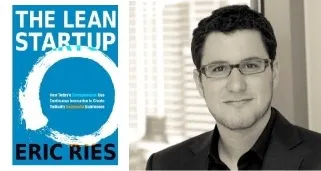Somebody please ask my customer to behave - with Eric Ries, The Lean Startup

Interested in the world of startups and technology? Yes, you are. A book to read is Eric Ries’ The Lean Startup. It’s #2 on the New York Times Bestseller and filled with wisdom tailored to connect to the hearts and souls of engineers and business junkies. From Japanese lean manufacturing to analyzing virtual reality customers, Eric incorporates it all in his now-popular lean theory.FAILING FAST AND CHEAP
This is the crux of The Lean Startup - how to gain validated “learning” from failure in the cheapest, fastest way possible, until you begin to succeed.
Eric became a student of failing fast after his stint as a senior software engineer at There.com – an online 3D virtual world founded in 1998. “There.com took 4 years and $40-50mm to build and it is important to appreciate how colossal a failure it was. And yet, while we were busy developing it for years, everyone told us how smart we were”.
In 2004 as the co-founder and CTO of IMVU (online social gaming with 3D avatars), Eric and his team codified the processes they used to ship product in 6 months and this formed the early beginnings of what became Lean.
The Lean Startup evangelizes prototyping and taking a Minimum Viable Product (MVP) to the customer early and often – we are talking weeks and days here. This is very difficult (of course). Customer response then gives you quick feedback on your prototype/MVP, which can help you improve your product for the next “release” cycle. This is where things get really ugly.
DO MY CUSTOMERS KNOW WHAT THEY WANT?
Eric was back home in Palo Alto from tour and stopped by at Stanford for a chat to answer the questions of eager entrepreneurs who had read his book and had some worried questions on how to interpret their customer feedback:
1. We are doing some split testing (2 different customer groups) and are worried that our sample size is too small. How do we know to believe the results?
What people forget when they talk about sample size is that you don’t always need it to be large. Often you have a small group giving you consistent, coherent feedback – i.e. signal without noise.
When Eric was CTO at IMVU (3D chat), they ran focus groups where they paid people to download their product and test it. During early market research, Eric had 5 paid focus group participants unanimously refuse to download the product because they felt it was weird. At first he was upset at the customer. Then he was upset at the people who hired the focus groups.
And then he realized that a sample set of 5 was enough to tell him something’s wrong. Why? No noise. At times, n=5 is statistically significant.
2. Apple says customers don’t know what they want. Should I trust my customer?
What Apple and Facebook are doing when they seemingly go against consumer voices to release much-criticized products into the market is this – they are watching consumer behavior. As long as consumer behavior is changing or is positive, they have the confidence to “rebel” against “experts”. Many people think that they are being courageous and visionary, and that they understand what the consumer wants, even if the consumer denies it but all they do is monitor consumer behavior. Facebook’s new Timeline might be much maligned but as long as Zuckerberg has data to show that it increases new-user addiction, he will release it.
Extending this philosophy, the only measure of performance in a startup should be whether you are building something or doing something that the customer values. Yes? You stay. No? You leave.
3. What if shipping a minimum viable product damages my reputation with the customer?
Lean is not about shipping poor quality product or killing customers. It’s testing with a batch size of 1. If the product damages your reputation, it might not be viable. “The Steve Jobs I admire is not the one who shipped the iPad, it’s the one who shipped APPLE I. That’s where he started”, said Eric.
4. How do I know when to “Pivot” and when to “Persevere”?
“This is tough,” said Eric.Almost everyone who pivots wish they had changed their business model earlier. You usually have inklings of a doubt early on and one solution might be to convene a meeting early. Ask people what they think about options and if they are already more excited about another business model than the one you are rolling out, maybe the time is to Pivot.
The evening had much other food for thought but if I took away one thing it was to immediately make a few landing pages for my ideas! Why wait when you can double check today?






